Korg KRONOS 88 LS Review – Is This the Ultimate All-in-One Keyboard?
The 88 LS is the latest in the KRONOS workstation range, a keyboard so feature-packed, it is touted as Korg’s most powerful synth ever. Andy Jones powers up Price £2,779 Contact Korg | www.korg.com | Korg on 01908 304600 KRONOS 88 LS key features: Workstation with 9 engines (piano, electric piano, organ, 3 x analogue […]
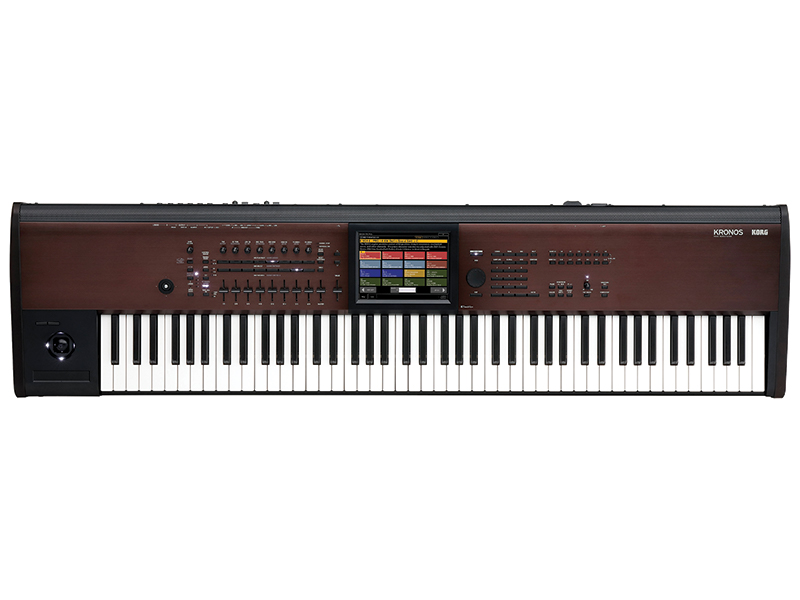
The 88 LS is the latest in the KRONOS workstation range, a keyboard so feature-packed, it is touted as Korg’s most powerful synth ever. Andy Jones powers up

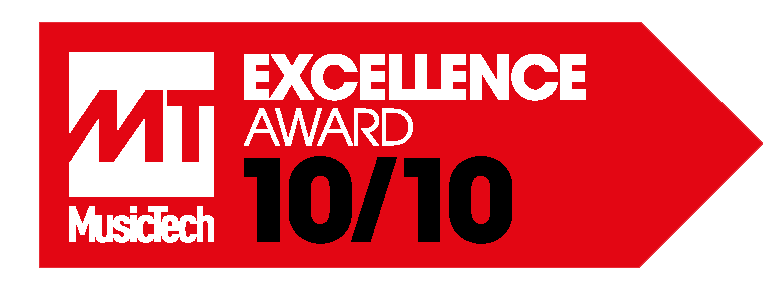
Price £2,779
Contact Korg | www.korg.com | Korg on 01908 304600
KRONOS 88 LS key features:
- Workstation with 9 engines (piano, electric piano, organ, 3 x analogue and 2 x digital synth, physical modelling
- Keyboard 88-note velocity-sensitive semi-weighted
- Polyphony up to 200 notes
- Sequencer 16 track MIDI plus 16 HDR
- Presets 896 Programs; 1792 Combinations
- Effects 16 simultaneous from 197 types
- Connections Main plus 4 individual outs, 2 audio in,3 pedal, 3 MIDI, USB
- Weight (kg) 17.8
- Size (w x h x d mm) 1,426 x 364 x 134
When Korg says that the KRONOS 88LS is its ’most powerful synthesizer ever’, you kind of have to sit up and take notice. The company’s history of making synths stretches back 45 years to its first offering, the Korg miniKORG-700. Since then it has released many landmark instruments and game-changing synth ranges.
There was the MS-20, Polysix and MonoPoly that helped define synth pop; the Poly-800 which was one of the first cheap programmable synths (and one of my first experiences with a synth); the M1 that soundtracked the late 80s; the Wavestations, Trinitys and Tritons of the 90s and 00s (plus my personal favourite, the massive-sounding physical modelling joy that was the Prophecy); right up to the Krosses and KRONOSes of today.
So Korg has form in making synths, and what I have before me is its most powerful synthesizer ever. Welcome to the KRONOS 88 LS.
The ultimate workstation
The KRONOS workstation was announced in 2011 and has been released in various forms and limited edition colours. The 88 LS is the most recent and very much the pinnacle of the range, designed to appeal to jobbing musicians and players, plus studio composers and producers alike. It’s lightweight and more portable than most 88-note keyboards, so gigging musicians will love it, and it comes packed with a simply stunning set of features. Hold your breath and read this lot…
So, the workstation concept is simple: pack as much as you can into a single keyboard for complete tune-making. That’s a synth, effects, sequencer, sampler and as many other bells and whistles that will damn well fit in. KRONOS 88 LS takes the concept a few steps further. Why have just one synth engine when you can have nine, covering everything from Premium Piano to several analogue and digital synths. Then there are 16 simultaneous effects; 21GB of sound data plus 62GB of sampling memory; an 800 x 600 pixel ’SVGA colour TouchView display’; a 16-track MIDI Sequencer and 16-Track Audio Recorder; up to 200 voices of polyphony; 1,505 Multisamples and 1,388 Drum samples…
I could go on, as each of the nine engines can then be broken down into subsets of more specs, but I think you get the picture: if you need to make some music, that music can almost certainly be made with KRONOS 88 LS.
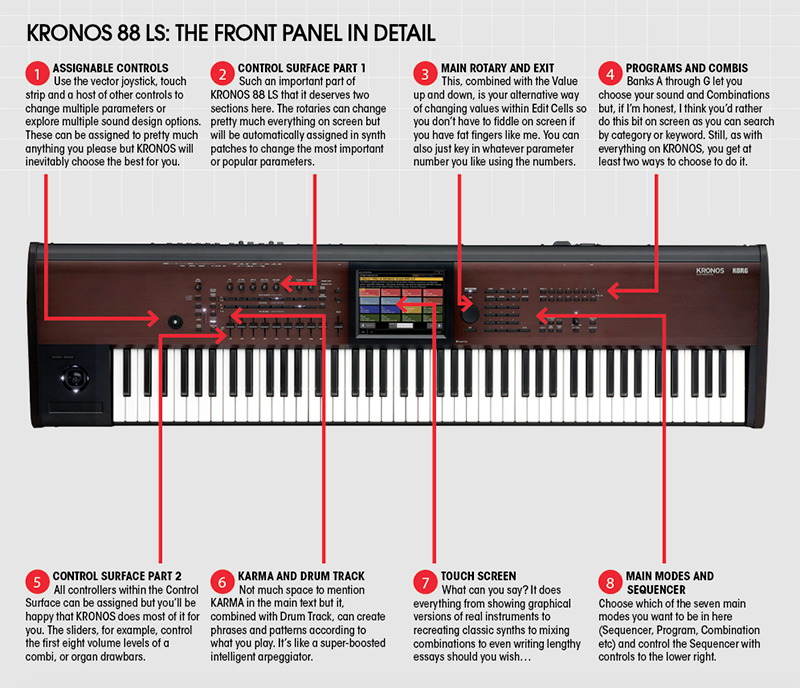
In use
KRONOS has seven main modes which you’ll probably be familiar with should you have used a synth workstation like this before. Program Mode is for playing individual sounds; Combination Mode is for combining 16 sounds together for keyboard splits and layers; Sequencer Mode is for the 16 tracks of MIDI and audio recording; Set List Mode allows you to access Programs, Combinations, even complete songs and more all from one place (great for gigging when you need to dial up the elements that make up a song or entire set); Sampling Mode is for getting your own audio recorded and organised; Disk Mode for extensive saving and loading options; and finally Global Mode for changing the main keyboard features.
So far, so normal. But a real strength of KRONOS is staring you in the face from the centre of the keyboard: the large touch screen. You use this to navigate around pages within the main modes, using a tab system. It’s pretty simple to understand. Tabs at the very bottom represent pages within pages so you’re going deeper, but any time you want you can reverse out by pressing the Exit button, and the more times you press it, the further back ’up’ you go. The screen is excellent, although in some Modes – Combination, for example – there is a lot going on. You do have to be fairly careful with your touches and mistakes can be made. Fortunately, there are ’off-screen’ options to edit parameters should you need them.
For example, when you highlight a parameter to change – known as the Edit Cell – you could use the screen with touch and drag up and down or left and right. If you find this too fiddly then use the Value controllers (switches and slider) on the front panel, or the main rotary, or simply dial in the number on the keypad. Lots of options then.
The screen works extremely well in conjunction with the KRONOS control surface area to its left. Here you or KRONOS decide what hardware controls are linked to whatever is on screen so whether, for example, the faders control the volume for the first or second eight parts of a Combination.
To the right of the screen is the main area for dialling up Programs and Combinations. Sounds are spread out through banks A to G and then a user bank of A to G. You can also access another user bank AA to GG by pressing the Preset and User bank buttons simultaneously or, of course, using the touch screen which accesses all Programs and Combinations. To be honest, I think this is where you will make all of your Program selections because you can search for sounds from 16 categories (plus two user) so it’s a lot quicker to home in on something. There’s even a search facility. As to the sounds themselves, well, where to begin?
Screen views from the KRONOS touch screen
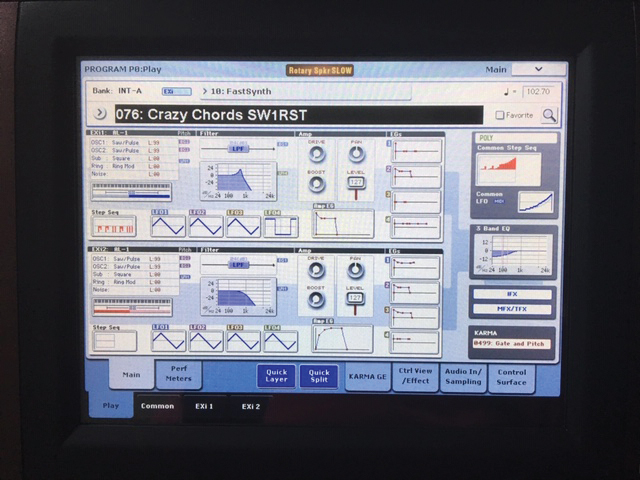
1. Program mode
You get an incredible level of access to each sound, including graphical editing to each of the engines that makes up the Program.
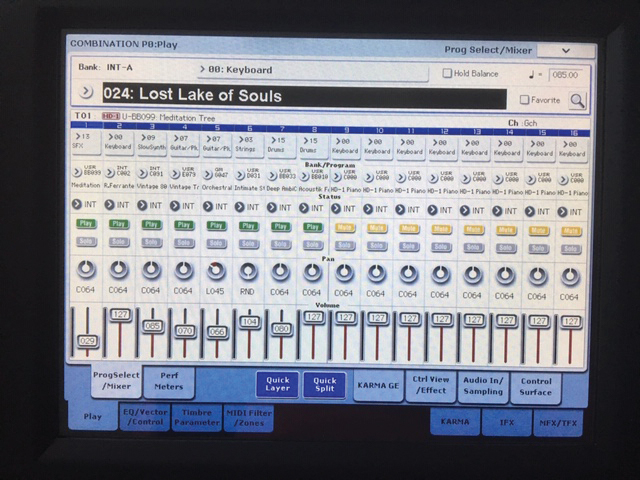
2. Combinations
In a Combination, you get up to 16 sounds layered together or played individually and complete control over all mix parameters.
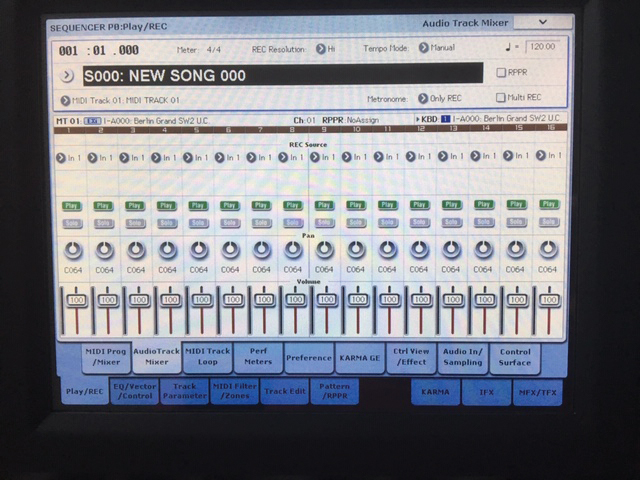
3. Sequencer
Fancy a sequencer which does most of what your computer-based DAW does, but in a keyboard? KRONOS delivers all your song-making needs.
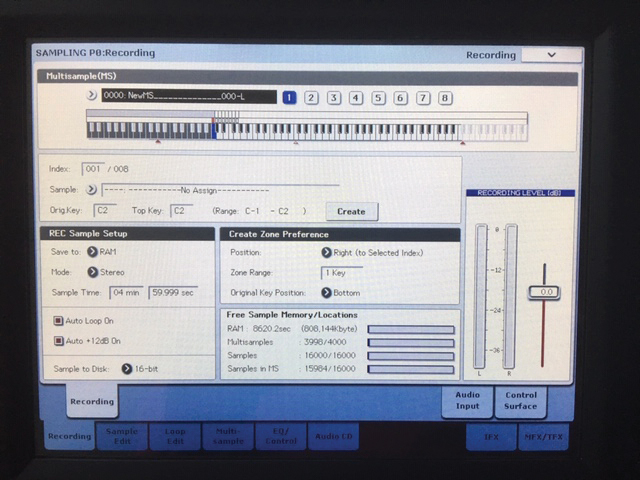
4. Sampling
I didn’t touch too much on the sampling capability of KRONOS in the main text but, suffice to say, its audio handling is second to none.
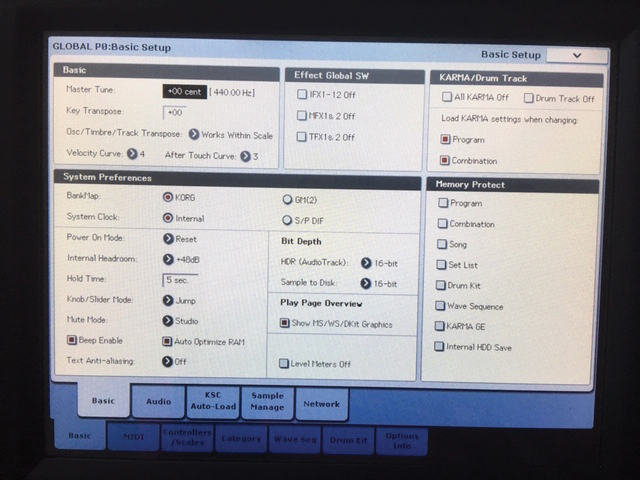
5. Global
In the Global Mode you can set everything up from how much Karma works with you to the master tune and global effects.
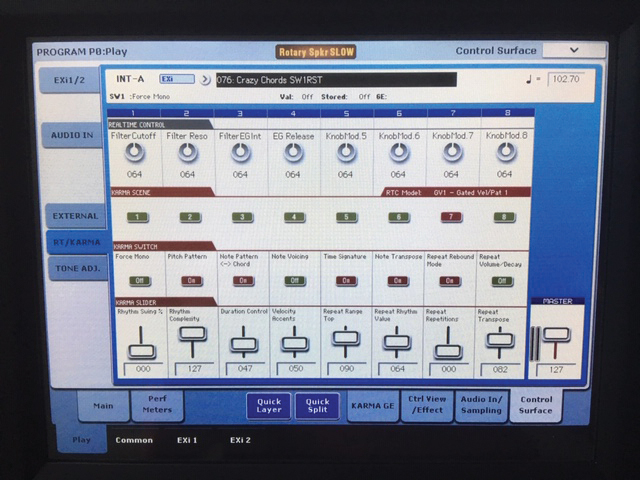
6. Control surface
Finally, a standout feature of KRONOS is its Control Surface that sets itself up most of the time, but is fully editable with the touch screen.
The KRONOS sound
KRONOS uses Smooth Sound Transitions, so one of the first things you’ll notice when you step through the presets is that they don’t suddenly cut off when switching from one Program or Combination to the next. Each program can feature two of the KRONOS’ nine engines as its main ingredients, so it’s probably best to look at each of these and rate the types of sounds they produce.
I’ll start with the SGX-2 piano engine. This is based on samples from three pianos – Japanese C, German D and Berlin D – and each note recorded with up to 12 velocity layers. A very cool feature on KRONOS is that you can adjust some instrument features graphically on screen so with the piano, for example, you can adjust how far the lid is open or closed. The resulting sounds are excellent across the board, and combined with the light feel of the 88LS keyboard deliver quite stunning results.
Similarly, the EP-1 engine offers amazing electric pianos. You get separate control over the piano tone and the mechanical noise resulting in a sound that feels like it’s from the genuine instrument.
With the CX-3 organ engine, the KRONOS Control Surface automatically turns into a drawbar section to adjust the tones (which can also be adjusted by on-screen drawbars). You can introduce a great Leslie effect by flicking the joystick forward. The results are amazing, with a great amount of bite and dirt.
For what you might call the ultimate digital synth, KRONOS 88 LS comes with a hell of a lot of analogue attitude courtesy of three of its engines: MS20-EX, PolySix EX and AN-1. You get a full representation of the synths in different parts so you can tweak a knob on screen or patch it by dragging virtual cables. The MS-20EX is unsurprisingly a recreation of that legendary synth… with many a bell and whistle added.
Step forward a few years to the PolySix and again you get a virtual realization of the original on screen, with the KRONOS control surface automatically set to adjust each one. Like the MS-20, this is beautiful in operation and you wonder if KRONOS 2049 will have just about every synth in Korg’s history implemented behind it. AL-1 is very much the up-to-date analogue engine which again uses modelling to create its lush, analogue tones. Overall you wouldn’t think these were digital recreations of analogue classics; they sound rich and deep and the amount of control you have over the sound is incredible.
With all of the synth sections – actually all the engines but it’s more tailored for the synths – you can get to the heart of each sound with full on-screen editing. The graphics reveal a sound and parameters in all its glory, going deep if you want to or providing a summary of the main characteristics on each Program’s main page. The screen really does invite sonic tweaking, as does the KRONOS control surface, which is mapped to the most common synth parameters for more tactile control, and with both that and the screen combined, it’s easy to get sidetracked and lost in the joys of sound design.
The next engine is the STR-1, a physical modelling sound source behind the string and plucked presets on KRONOS. Here the Control Surface controls functions like string type and damping to great effect.
The last synth engine is the HD-1 sampling synth, responsible for more ’real’ sounds on KRONOS but also features waveshaping synthesis for more rhythmic and evolving sounds – a varied beast then. It’s behind a lot of the KRONOS sounds and a big part of its sound.
Combinations of the Programs – up to 16 of them – are selected in the same way and cover everything from splits to almighty layers. If you think there was enough going on with a Program that utilises two synth engines, imagine what 16 of them can do together! The results are simply incredible.
Finally, on the sounds I should also mention that controllers such as the vector joystick and ribbon, can all be assigned to change multiple parameters at the same time so you can introduce very dramatic real-time changes in performances.
A zillion other features
This is a mighty beast and I’ve hit the last page without covering a multitude of its other capabilities, so I’ll attempt to skate over some now. First up is Karma, KRONOS’ attempt at AI, a kind of grown-up auto accompaniment but a lot better than that sounds. You select Karma Mode and the main front panel sliders are automatically set to control parameters of patterns, riffs and drums that auto-play around notes and chords that you play.
It’s instant song creation and the sliders control the note pattern, durations, and rhythm, generally making patterns more complex as you move left to right. I’ve never been a huge fan of keyboards interpreting and adding notes around what I play but I have to say Karma does it well and you can quickly get ideas and musical directions, all of which can be recorded into the sequencer (or your DAW) if you are lacking creativity.
Talking of the sequencer, it is, of course, fully featured but one of the highlights includes song templates, set up in genres with suitable programs automatically included within a Combination. So you might get a suitable bass set up on track two within a reggae template which will even have your levels and panning set up.
Using the sequencer really does demonstrate how well KRONOS has been designed in terms of its screen and Control Surface. The screen almost looks computer-like in its operation, not quite like a DAW but with almost as many sequencing options and the Control surface to the left of it automatically sets itself up to mix volume levels with the faders and pan with the rotaries. Everything works beautifully in tandem and operation soon becomes totally intuitive.
Conclusion
Trying to cover everything on KRONOS 88LS is hard but that last point on the sequencer sums up just how well this workstation works. And this latest version of Korg’s workstation, with its super-light and full-on keyboard is all things to all players, whether in the studio or live arena. The screen is its heart and the nine engines its soul and the combination, like recreating those classic Korg synths, is stunning. KRONOS is more expensive than cheaper workstation I’ve looked at (including Korg’s own Kross, and Yamaha’s MODX) will get you complete tunes.
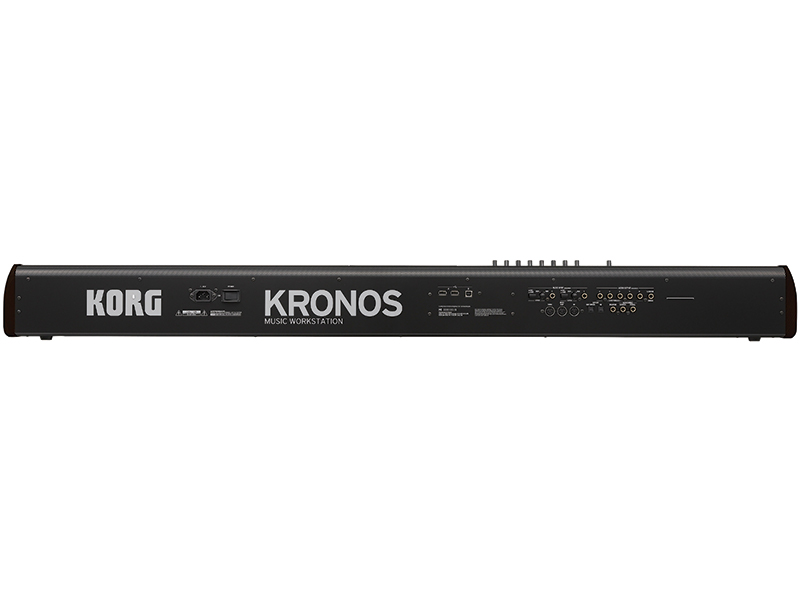
But the reason KRONOS 88 LS is expensive is its playability and the fact that it is the best of the KRONOS range, a range that has been tweaked to perfection over the last seven years. Is it Korg’s most powerful synth ever then? Well, it contains the equivalent of three analogues, a wavestation, an FM synth, and throws in a load of acoustic and electric instrumentation for good measure. You do the synth maths.
Do I really need this?
Are you the sort of person that likes everything in one box? KRONOS 88 LS is literally everything in one box. Full-sized keyboard, full-sized sequencer, sampler, synth (times about six), proper piano and organ all housed in a ruddy great big package that you can actually carry. It’s like it’s trying to put an entire band out of business. Of course, you could consider a computer as an all-in-one box, and a fully-loaded one (say with Kontakt and a bunch of other soft synths) might set you back an equivalent amount of money.
But if you’re still leaning towards a hardware workstation, then you really won’t find much better than KRONOS 88 LS. So, you do need it then, right? Well, maybe not. Do consider that the size and keyboard action make this a proper player’s workstation. If you are not such a person, then you might consider one of the smaller models in the KRONOS range, like the 61-note, still packed with the same features but around £1,300 less.
Alternatives
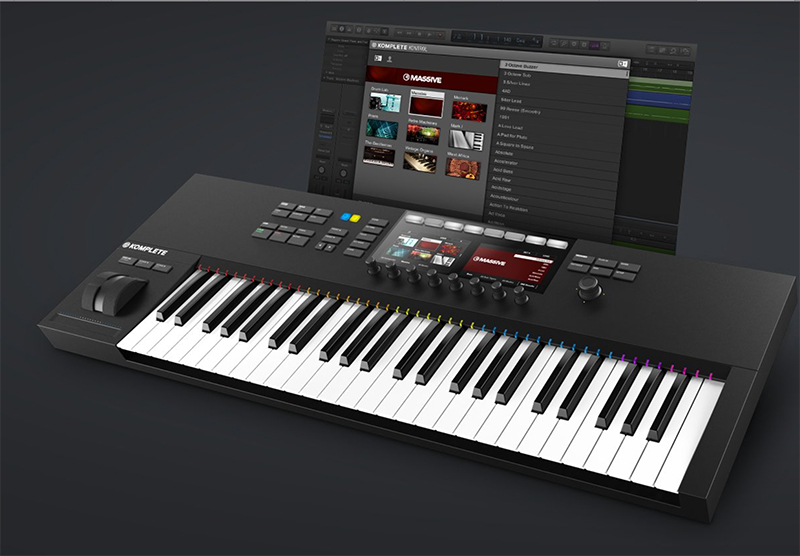
NI
Komplete Ultimate + Komplete Kontrol £800-£1,500
OK, it’s not a hardware synth, but if you are just starting out and want everything in one box, you could get yourself an Apple and this lot for less than the price of a KRONOS 88 LS.
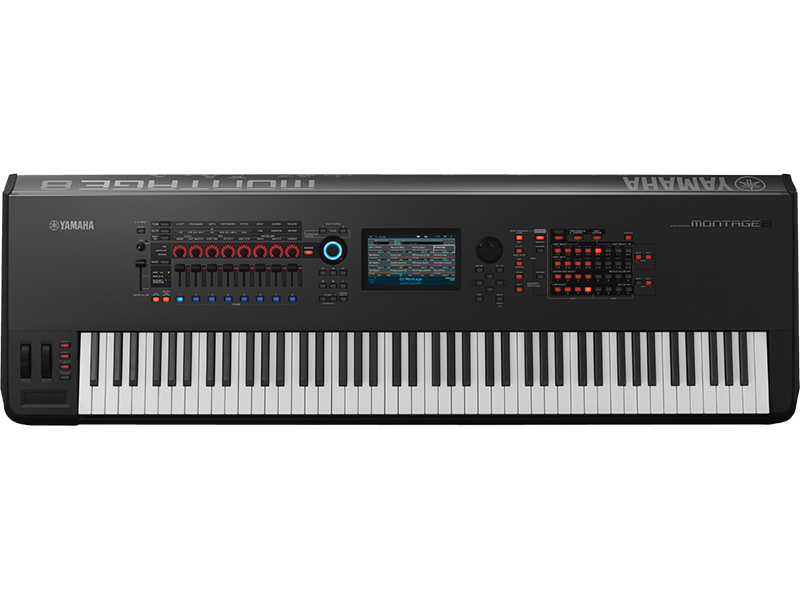
Yamaha
Montage Around £3,000 for the 88-note
I reviewed Yamaha’s equivalent mothership a while back. Like KRONOS it pretty much does everything and has a lovely touch screen. I’d argue that its focus is perhaps a little more on sound creation and exploration though.